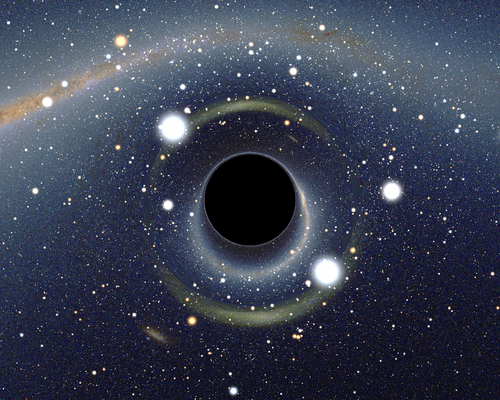General Astronomy/Black Holes/Hawking Radiation
Hawking Radiation
[edit | edit source]Hawking radiation is a theoretical effect produced by black holes. The idea was first put forward in 1972 by Jacob Bekenstein, a research student at Princeton, and improved upon by Stephen Hawking in 1974. Hawking's theory predicted that black holes should eventually decay or “evaporate” over time. This evaporation is based on the idea of thermal radiation with a black body radiation spectrum corrected for quantum effects coupled with the idea of vacuum energy.
Vacuum energy is the theoretical energy present in space, even in the absence of matter-energy. The theory postulates that empty space fluctuates and generates pairs of virtual particles of matter or energy. One particle is matter, the other antimatter. No sooner are they generated than they annihilate each other, thus keeping from violating the law of conservation of matter and energy.
Hawking’s theory postulates a particle pair generated from vacuum energy straddling horizon of a black hole, with one particle inside the horizon and its counterpart just outside the horizon. Then it would be possible for the large gravity of the black hole

to pull the two particle apart before they could annihilate each other and thus change the two from virtual particles to real particles. If then one of particles escaped while the other was pulled into the black hole, to the outside observer the black hole will have radiated a particle. This means that the black hole has lost some of its energy, and since we live in Einstein’s universe where matter and energy are combined to make matter-energy, the loss of some of its energy means that it is less massive than it was before it emitted the particle.
Now, if you are worried that the universe is in danger of losing its black hole population - don’t be. Hawking radiation only has a noticeable effect on black holes of around 10^12 kg [1]. or smaller. This is because a black hole must be starved to death; that is, the matter-energy it emits must be greater than the matter-energy it takes in. Since a black hole's mass is inversely proportional to its temperature, and the amount of matter-energy that it radiates is dependent on its temperature, then as the mass of the black hole increases, the amount of matter-energy that it emits decreases. So for larger black holes such as one about the mass of our sun, their temperature is very low (about 10^-7 K) so they have very low radiation. And since they receive light from stars, cosmic background radiation, and even matter in the form of dust, planets and stars, they continue to grow. It will only be at some future date when all stars have gone out, matter is out of reach of large black holes, and the temperature of the universe is less than that of the black hole itself, that the larger black holes will begin to evaporate.
Now that I have given you a brief overview of Hawking radiation and what it means, we can begin to delve deeper into what it is, how it works, and what its implications are.
Firstly, let’s refer back to vacuum energy. According to quantum field theory, all fields must be quantized at each and every point in space. Since a “vacuum” can be a space in which all energies cancel, you can make calculations of quantum field theory based on this model. You can model an expectation value for vacuum energy. The lowest possible energy for a quantized simple harmonic oscillator is E=1/2 ℏω. If you sum this energy over all points in space, you get an infinite quantity, thus giving rise to electron-positron creation and annihilation. When these particles are created at an event horizon of a black hole and one is pulled into the black hole before the pair can annihilate, the resulting Hawking’s flux arises from one particle being cast off to infinity[2]
If you look at a black hole in its simplest form - that of a non-rotating, non-charged Schwarzschild black hole of mass M - you can calculate the temperature of the perfect black body radiation emitted by the black hole using the Hawking's radiation temperature formula. | |
This coupled with the Schwarzchild radius

and the Stefan-Boltzmann power law:
allows you to derive the Stefan-Boltzmann-Schwarzschild-hawking power law:
for black hole radiation.
To put this in perspective, a black hole with one solar mass will have the small output of 9.003*10^-29 watts. From this we can calculate the time it would take for a black hole to evaporate in a completely empty universe. Now we see why it takes so long for black holes to evaporate, since the time of evaporation is proportional to the cube of its mass. However, this time is only theoretical because, in reality, the universe contains cosmic background radiation - among other things - so even a very isolated back hole would have to be smaller in mass than 0.8% of the earth to begin to evaporate.
Hawking’s radiation has many implications; one of them explains why scientists feel safe creating microscopic back holes. A black hole that lasts for even a second would need to have a mass of 2.28*10^5 kg, and since they are colliding much smaller particles, the time that each black hole exists is micro-seconds, possibly nano-seconds. This also means that as a black hole evaporates, unlike most objects, its temperature goes up (or as it grows, its temperature goes down). So in effect, perhaps some of the coldest things in the universe are the super massive black holes at the center of galaxies.
References
[edit | edit source]- ↑ C. Peters, Joseph Silk, Sadegh Khochfar, Joseph Silk. AccessScience. 16 March 2010 <http://www.accessscience.com/content.aspx?searchStr=hawking+radiation&id=085900>
- ↑ Nielsen, Alex B. "Black Holes without Boundaries." International Journal of Modern Physics D: Gravitation, Astrophysics & Cosmology 17.13 (2008): 2359-66.




